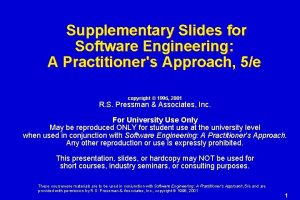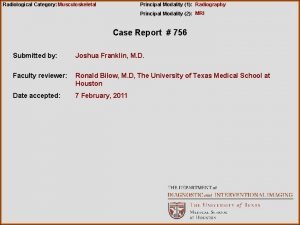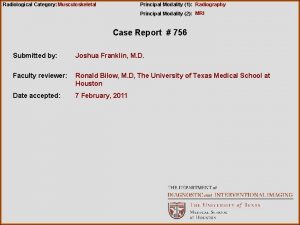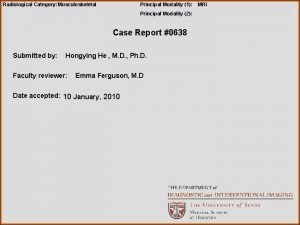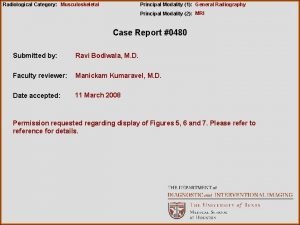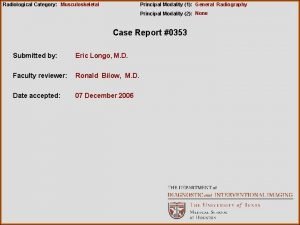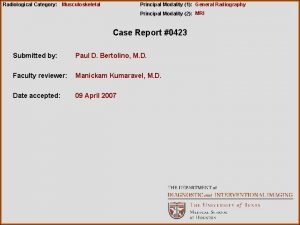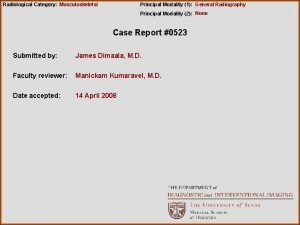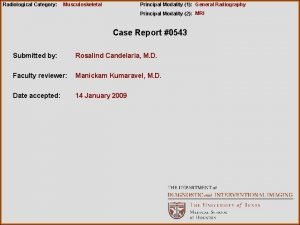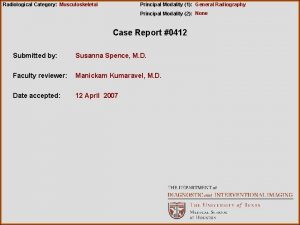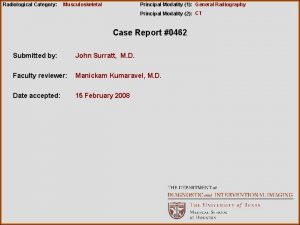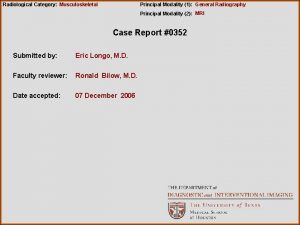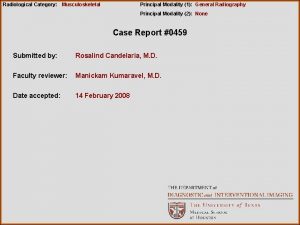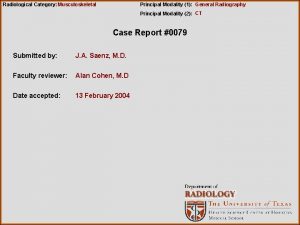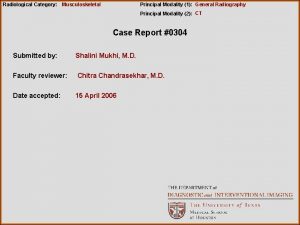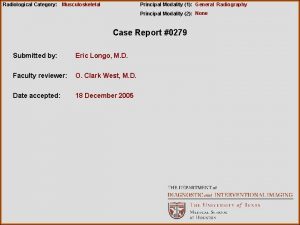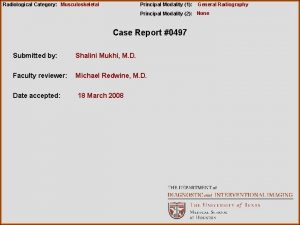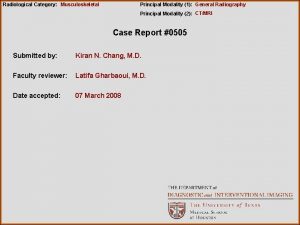Radiological Category Musculoskeletal Principal Modality 1 General Radiography


















- Slides: 18

Radiological Category: Musculoskeletal Principal Modality (1): General Radiography Principal Modality (2): MRI Case Report #0461 Submitted by: John Surratt, M. D. Faculty reviewer: Manickam Kumaravel, M. D. Date accepted: 15 February 2008

Case History • A 26 -year-old woman with ALL, currently in remission, presents with left elbow pain of 10 days duration. The pain is shooting in character and is altered by changes in position. She notes that the pain is most severe in the morning and at bedtime. There is no history of elbow trauma. No fever, chills, or visible inflammatory changes are present. • The initial radiographs and MRI images are provided, followed by 5 -month follow-up images.

Radiological Presentations

Radiological Presentations

Radiological Presentations

Radiological Presentations

Radiological Presentations

Radiological Presentations At 5 -month follow-up

Radiological Presentations At 5 -month follow-up

Radiological Presentations At 5 -month follow-up

Radiological Presentations At 5 -month follow-up

Radiological Presentations At 5 -month follow-up

Test Your Diagnosis Which one of the following is your choice for the appropriate diagnosis? After your selection, go to next page. • Panner’s disease • Avascular Necrosis • Lymphoma • Infection

Findings and Differentials Findings: The initial radiographs are normal. On the initial MR, increased T 2 signal intensity is noted throughout the lateral condyle, principally involving the capitellum. A small joint effusion is present. A focal disruption in the cortical contour of the capitellum is seen on the sagittal image. On the follow-up radiographs, there is interval development of lucency within the capitellum extending from the articular surface proximally, and bordered by a marginal zone of sclerosis. There is subtle loss of the previously seen smooth articular contour in the capitellum. On the follow-up MR, chondromalacia and subchondral fragmentation have developed. Differentials: • Avascular necrosis • Osteomyelitis

Discussion The osteochondroses are a collection of childhood conditions where the principle unifying pathophysiology is avascular necrosis (AVN) of a growing epiphysis or apophysis. Radiographically, these conditions appear identical. Though there is variation in the clinical scenario associated with each of the osteochondoses (i. e. jumping vs. pitching), the principle distinguishing factor between the eponymous osteochondroses is simply which joint is affected (i. e. Panner described the osteochondrosis of the capitellum). While the term osteochondrosis is restricted to AVN of growing epiphyses/apophyses, the term AVN applies to the pathophysiologic process itself and encompasses a much broader group of conditions. Though still poorly understood, the central mechanism is essentially sterile interruption of vascular supply to the bone, followed by bone necrosis. Numerous risk factors for this interruption of vascular supply have been identified and include steroid use, sickle cell anemia, trauma, and recent renal transplant, as well as multiple other disease states. The radiographic phases of bone necrosis have been classically described as joint effusion, patchy bone sclerosis, linear subarticular lucency, and finally articular surface collapse and fragmentation. However, even the first radiographic changes are late in the pathologic course of the disease.

Discussion MR is sensitive for early AVN, prior to any radiographic changes. Early MR findings include simple nonspecific bone edema. Low T 1 signal intensity serpiginous borders are seen in more advanced disease. Chondral loss and osseous fragmentation are late changes. Early diagnosis by MRI leads to early intervention to preserve the joint and a better prognosis. The patient in this case is skeletally mature. There is no history of trauma and no clinical evidence to suggest osteomyelitis. The entire joint is not involved. This case demonstrates radiographically silent disease at presentation. The contemporaneous MRI images show marked bone edema, a small joint effusion, and even subtle cortical disruption. The follow up images at 5 months demonstrate progression of disease, with areas of lucency, sclerosis, and articular collapse.

Diagnosis Avascular necrosis of the capitellum.

References 1. Helms CA: Fundamentals of Skeletal Radiology, 3 rd ed, 2005. 2. Chew FS: Muskuloskeletal Imaging, 2003. 3. AFIP syllabus, 2007.
 Pa erate
Pa erate National radiological emergency preparedness conference
National radiological emergency preparedness conference Radiological dispersal device
Radiological dispersal device Tennessee division of radiological health
Tennessee division of radiological health Center for devices and radiological health
Center for devices and radiological health Cardinality and modality
Cardinality and modality Modality microsoft services
Modality microsoft services Epistemic modality
Epistemic modality Birafs
Birafs What is modality in statistics
What is modality in statistics Stefan savi
Stefan savi Modality in software engineering
Modality in software engineering Entity class in software engineering
Entity class in software engineering Deontic and epistemic modality exercises
Deontic and epistemic modality exercises Modality in software engineering
Modality in software engineering Data modeling fundamentals
Data modeling fundamentals Lexical vs auxiliary verbs
Lexical vs auxiliary verbs Skill focus: persuasion
Skill focus: persuasion Pacs modality workstation
Pacs modality workstation











